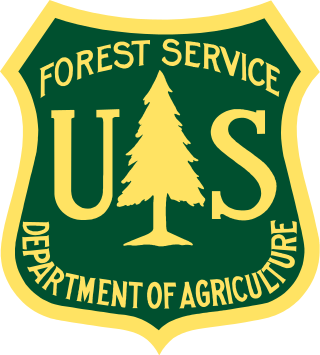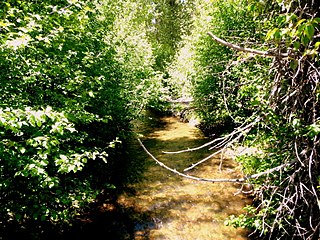Related Research Articles

A forest is an area of land dominated by trees. Hundreds of definitions of forest are used throughout the world, incorporating factors such as tree density, tree height, land use, legal standing, and ecological function. The United Nations' Food and Agriculture Organization (FAO) defines a forest as, "Land spanning more than 0.5 hectares with trees higher than 5 meters and a canopy cover of more than 10 percent, or trees able to reach these thresholds in situ. It does not include land that is predominantly under agricultural or urban use." Using this definition, Global Forest Resources Assessment 2020 found that forests covered 4.06 billion hectares, or approximately 31 percent of the world's land area in 2020.

The United States Forest Service (USFS) is an agency within the U.S. Department of Agriculture that administers the nation's 154 national forests and 20 national grasslands covering 193 million acres (780,000 km2) of land. The major divisions of the agency are the Chief's Office, National Forest System, State and Private Forestry, Business Operations, as well as Research and Development. The agency manages about 25% of federal lands and is the sole major national land management agency not part of the U.S. Department of the Interior.

In the United States, national forest is a classification of protected and managed federal lands that are largely forest and woodland areas. They are owned collectively by the American people through the federal government and managed by the United States Forest Service, a division of the United States Department of Agriculture. The U.S. Forest Service is also a forestry research organization which provides financial assistance to state and local forestry industry. There are 154 national forests in the United States.

Hood River County is one of the 36 counties in the U.S. state of Oregon. As of the 2020 census, the population was 23,977. The county seat is Hood River. The county was established in 1908 and is named for the Hood River, a tributary of the Columbia River. Hood River County comprises the Hood River, OR Micropolitan Statistical Area. The Hood River Valley produces apples, pears, and cherries. Situated between Mount Hood and the Columbia River in the middle of the Columbia River Gorge, Hood River County is a popular destination for outdoor enthusiasts, such as windsurfers, mountain-bikers, skiers, hikers, kayakers, and many more.

The General Revision Act of 1891, also known as the Forest Reserve Act of 1891, was a federal law signed in 1891 by President Benjamin Harrison. The Act reversed previous policy initiatives, such as the Timber Culture Act of 1873, which did not preclude land fraud by wealthy individuals and corporations. The acquisition of vast mineral and timber resources in the Western United States was often cited as a governing motive for such individuals and corporations to claim land rights for future settlement and resource depletion activities. The legacy of the General Revision Act of 1891 is frequently credited as its serving as a catalyst to a series of federal land reform initiatives, notably under President Theodore Roosevelt. From the Reclamation Act of 1902 to the formation of the United States Forest Service in 1905, the General Revision Act of 1891 acted as a critical first piece of federal legislation granting increased plots of publicly allotted land and decreased extraction rights to privately held western land owners in the early 20th century.

The American Tree Farm System (ATFS) is the largest and oldest woodland certification system in America. It is internationally recognized by the Programme for the Endorsement of Forest Certification and meets strict third-party certification standards. It is one of three certification systems currently recognized in the United States. ATFS specializes in certifying private forests, primarily those held by individuals and families and currently certifies over 24 million acres (110,000 km²) of forestland. The ATFS Standard for Certification is owned by the American Forest Foundation, a national nonprofit organization focused on promoting sustainable stewardship of America's woodlands and related environmental education through Project Learning Tree.

Christmas tree production in Canada totals from 3 to 6 million trees annually. Trees are produced in many of the provinces of Canada but the nation's leading producers are found in Quebec, Nova Scotia and Ontario, which account for 80 percent of Canadian tree production. Of the 900,000 trees produced annually in British Columbia, most are cut from native pine stands.

Forestry in India is a significant rural industry and a major environmental resource. India is one of the ten most forest-rich countries of the world. Together, India and 9 other countries account for 67 percent of the total forest area of the world. India's forest cover grew at 0.20% annually over 1990–2000, and has grown at the rate of 0.7% per year over 2000–2010, after decades where forest degradation was a matter of serious concern.

Sun Pass State Forest is one of six state forests managed by the Oregon Department of Forestry. The forest is located 40 miles (64 km) north of Klamath Falls, Oregon near the southeastern corner of Crater Lake National Park. It is the largest single block of Oregon state forestry land east of the Cascade Mountains. The forest is managed as part of the Klamath-Lake District, comprising 21,317 acres (86.27 km2) of the 33,739 state-owned acres within the district.
Private landowner assistance program (PLAP) is a class of government assistance program available throughout the U.S. for landowners interested in maintaining, developing, improving and protecting wildlife on their property. Each state provides various programs that assist landowners in agriculture, forestry and conserving wildlife habitat. This helps landowners in the practice of good land stewardship and provides multiple benefits to the environment. Some states offer technical assistance which includes:

It has been estimated that before European settlement, forests in the United States mainland, covered nearly 1 billion acres (4,000,000 km2). Since the mid-1600s, about 300 million acres (1,200,000 km2) of forest have been cleared, primarily for agriculture during the 19th century.

Conservation in India can be traced to the time of Ashoka, tracing to the Ashoka Pillar Edicts as one of the earliest conservation efforts in the world. Conservation generally refers to the act of carefully and efficiently using natural resources. Conservation efforts begun in India before 5 AD, as efforts are made to have a forest administration. The Ministry of Environment, Forest and Climate Change is the ministry responsible for implementation of environmental and forestry program in India, which include the management of national parks, conservation of flora and fauna of India, and pollution controls.

The forests in the U.S. state of Texas have been an important resource since its earliest days and have played a major role in the state's history. The vast woodlands of the region, home to many varieties of wildlife before Europeans first showed up, provided economic opportunities for early settlers. They continue to play an important role economically and environmentally in the state.
Agrarian reform and land reform have been a recurring theme of enormous consequence in world history. They are often highly political and have been achieved in many countries.

The Canadian forestry industry is a major contributor to the Canadian economy. With 39% of Canada's land acreage covered by forests, the country contains 9% of the world's forested land. The forests are made up primarily of spruce, poplar and pine. The Canadian forestry industry is composed of three main sectors: solid wood manufacturing, pulp and paper and logging. Forests, as well as forestry are managed by The Department of Natural Resources Canada and the Canadian Forest Service, in cooperation with several organizations which represent government groups, officials, policy experts, and numerous other stakeholders. Extensive deforestation by European settlers during the 18th and 19th centuries has been halted by more modern policies. Today, less than 1% of Canada's forests are affected by logging each year. Canada is the 2nd largest exporter of wood products, and produces 12.3% of the global market share. Economic concerns related to forestry include greenhouse gas emissions, biotechnology, biological diversity, and infestation by pests such as the mountain pine beetle.

The Barry Point Fire was a wildfire that burned over 92,977 acres (376.26 km2) of Oregon and California forest land during the summer of 2012. The fire began on 5 August 2012, the result of a lightning strike. The fire consumed public forest and rangeland as well as private forest and grazing land located in Lake County, Oregon and Modoc County, California. The public lands effected by the fire are administered by the United States Forest Service and the Oregon Department of Forestry. The largest part of the private land was owned by the Collins Timber Company. At the peak of the firefighting effort, there were 1,423 personnel working on the fire. It took 22 days to fully contain the fire and then an additional three weeks to mop it up.
Forest cover is the amount of forest that covers a particular area of land. It may be measured as relative or absolute. Nearly a third of the world's land surface is covered with forest, with closed-canopy forest accounting for 4 - 5 billion hectares of land. Forests provide many ecosystem services that humans and animals cannot survive without, but anthropogenic actions and climate change are threatening global forest cover in potentially irreversible ways.

The forest in Germany covers 11.4 million hectares, 32 percent of the total area of the country. In the German forests grow about 90 billion trees with a total wood stock of 3.7 billion cubic meters. The definition of the Federal Forest Act (BWaldG) for forest is: "any area planted with forest plants. Forest also includes clear-cut or shaded ground areas, forest roads, forest clearance and securing strips, forest meadows and clearings, forest meadows, grass clearing areas, wood storage areas and other areas associated with and serving the forest."
A private forest is a forest that is not owned by municipal authorities, church authorities or the state. It can refer to woodland owned by a natural or juridical person or a partnership.It is the forest which is planted, nurtured or conserved in any private land.
References
- ↑ Smith, W.B., P.D. Miles, J.S. Vissage and S.A. Pugh. 2002. “Forest Resources of the United States.” USDA, Forest Service (2002) General technical report. NC-241, 2004.
- ↑ Kuhns, M. R.; Brunson, M. W.; Roberts, S.D. (1998). "Landowners' Educational Needs and How Foresters Can Respond". Journal of Forestry. 96 (8): 38–43.
- 1 2 3 4 5 Watson, R. (April 2012). "Market access and forest stewardship".[ dead link ]
- ↑ Zhang Yaoqi Zhang Daowei John Schelhas (2005). "Small-Scale Nonindustrial Private Forest Ownership in the United States: Rationale and Implications for Forest Management". Silva Fennica. 39 (3): 443–454.
- ↑ Butler, Brett.J.; Leatherberry, Earl.C. (2004). "America's Family Forest Owners". Journal of Forestry. 102 (7): 4–9.
 This article incorporates public domain material from Jasper Womach. Report for Congress: Agriculture: A Glossary of Terms, Programs, and Laws, 2005 Edition (PDF). Congressional Research Service.
This article incorporates public domain material from Jasper Womach. Report for Congress: Agriculture: A Glossary of Terms, Programs, and Laws, 2005 Edition (PDF). Congressional Research Service.